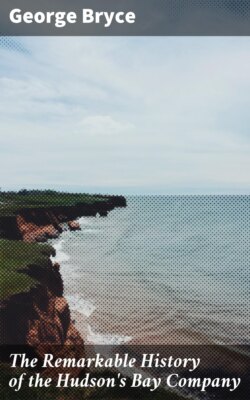Читать книгу The Remarkable History of the Hudson's Bay Company - Bryce George - Страница 13
На сайте Литреса книга снята с продажи.
ОглавлениеTwo ships were purchased by the Committee, the Dobbs galley, 180 tons burden, Captain William Moore, and the California, 140 tons, Captain Francis Smith. On May 24th, 1746, the two vessels, provisioned and well fitted out for the voyage, left the mouth of the Thames, being in company with the two ships of the Hudson's Bay Company going to the Bay, the four ships being under the convoy of the ship Loo, of forty guns, as France was at this time at war with England. The voyage was rather prosperous, with the exception of a very exciting incident on board the Dobbs galley. A dangerous fire broke out in the cabin of the vessel, and threatened to reach the powder-room, which was directly underneath, and contained "thirty or forty barrels of powder, candles, spirits, matches, and all manner of combustibles." Though, as the writer says, "during the excitement, you might hear all the varieties of sea eloquence, cries, prayers, curses, and scolding, mingled together, yet this did not prevent the proper measures being taken to save the ship and our lives."
The story of the voyage is given to us in a very interesting manner by Henry Ellis, gentleman, agent for the proprietors of the expedition. Though nearly one hundred pages are taken up with the inevitable summaries of "The Several Expeditions to discover a North-West Passage," yet the remaining portion of the book is well written. After the usual struggle with the ice in Hudson Strait, as it was impossible to explore southward during the first season, the Dobbs galley and the California sailed for Port Nelson, intending to winter there. They arrived on August 26th. Ellis states that they were badly received by the Hudson's Bay officers at the first. They, however, laid up their ships in Hayes River, and built an erection of logs on the shore for the staff. The officers' winter quarters were called "Montague House," named after the Duke of Montague, patron of the expedition. After a severe winter, during which the sailors suffered with scurvy, and, according to Ellis, received little sympathy from the occupants of York Fort, the expedition left the mouth of the Hayes River on June 24th, to prosecute their discovery. After spending the summer coasting Hudson Bay and taking careful notes, the officers of the vessels gladly left the inhospitable shore to sail homeward, and the two ships arrived in Yarmouth Roads on October 14th, 1747.
"Thus ended," says Ellis, "this voyage, without success indeed, but not without effect; for though we did not discover a north-west passage … we returned with clearer and fuller proofs … that evidently such a passage there may be." It will be observed that Ellis very much confirms Captain Middleton's conclusions, but Mr. Dobbs no doubt made the best of his disappointment, and, as we shall see, soon developed what had been from the first his real object, the plan for founding a rival company.
